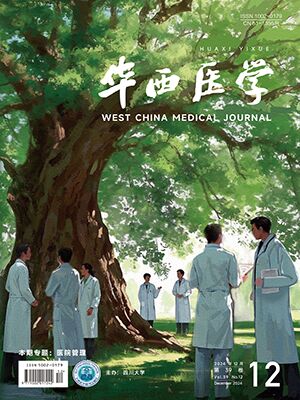| 1. |
Mederos MA, Reber HA, Girgis MD. Acute pancreatitis: a review. JAMA, 2021, 325(4): 382-390.
|
| 2. |
李非, 曹锋. 中国急性胰腺炎诊治指南(2021). 中国实用外科杂志, 2021, 41(7): 739-746.
|
| 3. |
Cho J, Petrov MS. Pancreatitis, pancreatic cancer, and their metabolic sequelae: projected burden to 2050. Clin Transl Gastroenterol, 2020, 11(11): e00251.
|
| 4. |
Li CL, Jiang M, Pan CQ, et al. The global, regional, and national burden of acute pancreatitis in 204 countries and territories, 1990-2019. BMC Gastroenterol, 2021, 21(1): 332.
|
| 5. |
Iannuzzi JP, King JA, Leong JH, et al. Global incidence of acute pancreatitis is increasing over time: a systematic review and meta-analysis. Gastroenterology, 2022, 162(1): 122-134.
|
| 6. |
Szatmary P, Grammatikopoulos T, Cai W, et al. Acute pancreatitis: diagnosis and treatment. Drugs, 2022, 82(12): 1251-1276.
|
| 7. |
Yang X, Yao L, Yuan M, et al. Transcriptomics and network pharmacology reveal the protective effect of Chaiqin chengqi decoction on obesity-related alcohol-induced acute pancreatitis via oxidative stress and PI3K/Akt signaling pathway. Front Pharmacol, 2022, 13: 896523.
|
| 8. |
Wen Y, Han C, Liu T, et al. Chaiqin chengqi decoction alleviates severity of acute pancreatitis via inhibition of TLR4 and NLRP3 inflammasome: identification of bioactive ingredients via pharmacological sub-network analysis and experimental validation. Phytomedicine, 2020, 79: 153328.
|
| 9. |
Han C, Du D, Wen Y, et al. Chaiqin chengqi decoction ameliorates acute pancreatitis in mice via inhibition of neuron activation-mediated acinar cell SP/NK1R signaling pathways. J Ethnopharmacol, 2021, 274: 114029.
|
| 10. |
Yang X, Zhang X, Lin Z, et al. Chaiqin chengqi decoction alleviates severe acute pancreatitis associated acute kidney injury by inhibiting endoplasmic reticulum stress and subsequent apoptosis. Biomed Pharmacother, 2020, 125: 110024.
|
| 11. |
Peng Y, Hong J, Raftery D, et al. Metabolomic-based clinical studies and murine models for acute pancreatitis disease: a review. Biochim Biophys Acta Mol Basis Dis, 2021, 1867(7): 166123.
|
| 12. |
Huang Y, Wen Y, Wang R, et al. Temporal metabolic trajectory analyzed by LC-MS/MS based targeted metabolomics in acute pancreatitis pathogenesis and Chaiqin Chengqi decoction therapy. Phytomedicine, 2022, 99: 153996.
|
| 13. |
Liang G, Yang J, Liu T, et al. A multi-strategy platform for quality control and Q-markers screen of Chaiqin chengqi decoction. Phytomedicine, 2021, 85: 153525.
|
| 14. |
Du W, Liu G, Shi N, et al. A microRNA checkpoint for Ca2+ signaling and overload in acute pancreatitis. Mol Ther, 2022, 30(4): 1754-1774.
|
| 15. |
Huang W, Cane MC, Mukherjee R, et al. Caffeine protects against experimental acute pancreatitis by inhibition of inositol 1, 4, 5-trisphosphate receptor-mediated Ca2+ release. Gut, 2017, 66(2): 301-313.
|
| 16. |
Du D, Yao L, Zhang R, et al. Protective effects of flavonoids from Coreopsis tinctoria Nutt. on experimental acute pancreatitis via Nrf-2/ARE-mediated antioxidant pathways. J Ethnopharmacol, 2018, 224: 261-272.
|
| 17. |
Zhang C, Wang K, Yang L, et al. Lipid metabolism in inflammation-related diseases. Analyst, 2018, 143(19): 4526-4536.
|
| 18. |
Yang X, Yao L, Fu X, et al. Experimental acute pancreatitis models: history, current status, and role in translational research. Front Physiol, 2020, 11: 614591.
|
| 19. |
Wei J, Liu X, Xiao W, et al. Phospholipid remodeling and its derivatives are associated with COVID-19 severity. J Allergy Clin Immunol, 2023, 151(5): 1259-1268.
|
| 20. |
Kurano M, Okamoto K, Jubishi D, et al. Dynamic modulations of sphingolipids and glycerophospholipids in COVID-19. Clin Transl Med, 2022, 12(10): e1069.
|
| 21. |
Dobszai D, Mátrai P, Gyöngyi Z, et al. Body-mass index correlates with severity and mortality in acute pancreatitis: a meta-analysis. World J Gastroenterol, 2019, 25(6): 729-743.
|
| 22. |
Khatua B, El-Kurdi B, Singh VP. Obesity and pancreatitis. Curr Opin Gastroenterol, 2017, 33(5): 374-382.
|
| 23. |
Wang Q, Wang G, Qiu Z, et al. Elevated serum triglycerides in the prognostic assessment of acute pancreatitis: a systematic review and meta-analysis of observational studies. J Clin Gastroenterol, 2017, 51(7): 586-593.
|
| 24. |
Zhang R, Deng L, Jin T, et al. Hypertriglyceridaemia-associated acute pancreatitis: diagnosis and impact on severity. HPB (Oxford), 2019, 21(9): 1240-1249.
|
| 25. |
Navina S, Acharya C, DeLany JP, et al. Lipotoxicity causes multisystem organ failure and exacerbates acute pancreatitis in obesity. Sci Transl Med, 2011, 3(107): 107ra110.
|
| 26. |
Sah RP, Garg P, Saluja AK. Pathogenic mechanisms of acute pancreatitis. Curr Opin Gastroenterol, 2012, 28(5): 507-515.
|
| 27. |
Wan MH, Huang W, Latawiec D, et al. Review of experimental animal models of biliary acute pancreatitis and recent advances in basic research. HPB (Oxford), 2012, 14(2): 73-81.
|
| 28. |
Hung ND, Kim MR, Sok DE. 2-Polyunsaturated acyl lysophosphatidylethanolamine attenuates inflammatory response in zymosan A-induced peritonitis in mice. Lipids, 2011, 46(10): 893-906.
|
| 29. |
Park SJ, Im DS. 2-Arachidonyl-lysophosphatidylethanolamine induces anti-inflammatory effects on macrophages and in carrageenan-induced paw edema. Int J Mol Sci, 2021, 22(9): 4865.
|
| 30. |
Khan SA, Ilies MA. The phospholipase A2 superfamily: structure, isozymes, catalysis, physiologic and pathologic roles. Int J Mol Sci, 2023, 24(2): 1353.
|
| 31. |
Scott KF, Mann TJ, Fatima S, et al. Human group IIA phospholipase A2-three decades on from its discovery. Molecules, 2021, 26(23): 7267.
|
| 32. |
Rajan L, Palaniswamy D, Mohankumar SK. Targeting obesity with plant-derived pancreatic lipase inhibitors: a comprehensive review. Pharmacol Res, 2020, 155: 104681.
|




